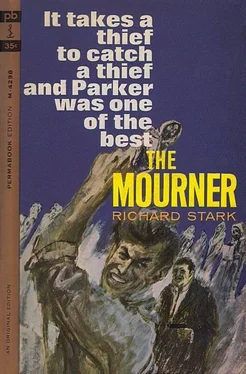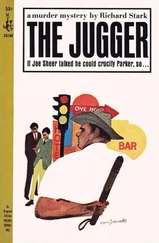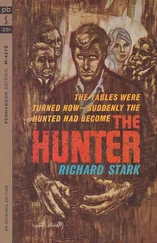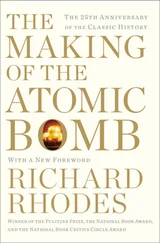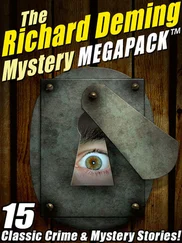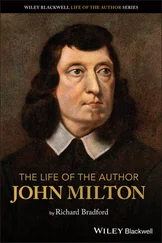He lay down on the seat and took out a pencil flash. He studied the underpart of the dashboard and found he would have to remove a small, flat plate. He put the flash away, got out a small screwdriver and, working by feel, removed the three screws that held the plate in place. Then he used the flash again, for ten seconds, and that was it. He sat up, slid over behind the wheel, and took a jumper wire out of his pocket, with sticky electric tape at both ends. He unreeled part of the tape and then, working by feel once more, reached down under the dashboard and put the jumper on. The starter caught, and slipped, and caught again, and then the engine was purring. He put the automatic transmission in Drive, and pulled away.
On Wisconsin Avenue there was a movie theater, and there was a supermarket, and a blacktop parking lot between them. In the daytime the supermarket customers used the lot, and at night the movie customers used it. Parker drove there, parked the Cadillac so there was a space on his left, stalled the car, and removed the jumper wire. Then he got out and opened the hood. He stood looking down for a minute, and then went to work. It was now twenty minutes to eight.
Handy and Menlo showed up in the Pontiac on schedule, at ten minutes to eight. They parked in the slot next to the Cadillac, and got out. Parker was just finishing. He closed the hood and said, “All ready.”
“Once again,” Menlo said, looking at the Cadillac with distrust, “I can only reassure myself with the knowledge that you are professionals in this type of activity. The idea of driving to a robbery in an automobile just recently stolen would never have occurred to me. Having occurred to me, it would terrify me so completely I would reject it.”
“This car won’t be hot for a couple of hours. By then we’ll be done with it,” Handy said.
“I trust your judgment implicitly,” Menlo assured him, “having seen you in action against those poor specimens supplied me by the Outfit. I have every confidence in you.”
“That’s good. Get in the car,” Parker said.
“Most certainly.”
Menlo got in the back again, and Parker and Handy up front. There was now a new set of wires by the steering shaft, ending in a small oblong fixture with a pushbutton. This was the new starter. Parker tested it out, and it worked fine. He backed the Cadillac out of its parking slot and drove it slowly out onto Wisconsin Avenue.
Kapor’s house, when they got there, was in darkness, the way it was supposed to be. Parker spun the wheel and the Cadillac entered the driveway. The tires crunched on the gravel. The Cadillac looked right at home here as Parker tooled it around behind the house and left it in front of the garage, hidden from the street by the house.
It was eight-thirty. They were right on schedule.
There were two back doors to choose from and they picked the one that Clara had reported led to the kitchen. Handy went to work on it. He was very good with doors. It opened almost immediately.
They went in, and Parker turned on the pencil flash. From Clara, through Menlo, they now had a good ground plan of the house. His voice soft, Parker asked, “All right, Menlo. What room do we want?”
“We’ll get your statuette first,” Menlo said. “I have a desire to see it. This bit of romanticism you will not deprive me of.”
Parker shrugged. It didn’t make any difference. He crossed the kitchen and opened the door on the other side, which led to the rear staircase, the servants’ stairs.
The staircase ended on a squarish room, with a large table along one wall. On the other side was a doorless entranceway, leading to an L-shaped hall. Parker opened the third door on the left, and because this room faced the rear of the house, he switched on the light.
It was a long and narrow room, with a dark-red paper covering the walls. The lighting was soft, furnished by fluorescent tubes in troughs spaced along the upper walls, and a rich green carpet covered the entire floor.
It resembled a room in a museum. Glass-topped cases contained coins, resting on green velvet, and on squarish pedestals of varying height were statues of varying styles — of plaster, bronze, terra cotta, alabaster, wood — none over three feet tall. Around the walls fancy swords were hung, and a tall, narrow, glass-doored bookcase at one end of the room was half full of ancient-looking volumes. Most of them were thick and squat, with peeling bindings.
“It is all garbage,” Menlo said, with something like contempt in his voice. “Kapor is indiscriminate in his artistic affections. He buys because a particular item is for sale, not because it adds anything artistically. Look at this gibberish! What a confusion of styles and periods. What would Kapor do with a hundred thousand dollars, if he were allowed to retain it? Create an entire house of monstrosities such as this? Such tastelessness deserves no hundred thousand dollars!”
He moved deeper into the room, frowning. “There are good pieces here,” he said. “A few, but only a few. There’s a Gardner over there, one of the better moderns. But in such surroundings, how can anything reveal its true value? Ah! Here is your mourner!”
It stood in a corner, near the bookcase, on a low pedestal nearly hidden from view. White, small, alone, bent by grief, the mourner stood, his face turned away. A young monk, soft-faced, his cowl back to reveal his clipped hair, his hands slender and long-fingered, the toes of his right foot peeking out from under his rough white robe. His eyes stared at the floor, large, full of sorrow. His left arm was bent, the hand up alongside his cheek, palm outward and shielding his face. His right hand, the fingers straight, almost taut, cupped his left elbow, the forearm across his midsection. The broad sleeve had slipped down his left forearm, showing a thin and delicate wrist. His whole body was twisted to the left, and bent slightly forward, as though grief had instantaneously aged him. It was as if he grieved for every mournful thing that had ever happened in the world, from one end of time to the other.
“I see,” said Menlo softly, gazing at the mourner. He reached out gently and picked the statue up, turning it in his hands carefully. “Yes, I see. I understand your Mr. Harrow’s craving. Yes, I do understand.”
“Now the dough,” said Parker. To him the statue was merely sixteen inches of alabaster, for the delivery of which he had already been paid in full.
“Of course. Most certainly.” Menlo’s old smile popped back into place. He walked over and handed the statuette to Parker. “As you so ably expressed it, now the dough.” He turned, looking around the room and murmuring to himself, “Apollo, Apollo—” Then he snapped his fingers. “Ah! There!” He moved through the clutter of statues, a fat man weaving lithely, and stopped at a gray figure of a nude young man seated on a tree stump.
Parker and Handy followed him, Handy carrying the suitcase. Menlo patted the statue’s shoulder with pudgy fingers and smiled happily at Parker. “You see? A most ingenious solution. You have a figure of speech for this, I believe. One cannot see the forest for the trees. In this case, one cannot see the tree for the forest.”
“In there? In the statue?” Parker asked.
“Most certainly! Watch.” Menlo put his hands on the statue’s head, and twisted. There was a grating sound, and the head came off in his hands. “Hollow,” he said. “The young Apollo and his tree trunk, packed with money.”
He stuck his hand down inside and brought out a batch of greenbacks. “You see?”
“All right. Let’s pack it,” Parker said. Handy opened the suitcase and as Menlo brought forth handful after handful of bills, Parker and Handy stowed it all inside.
Читать дальше
